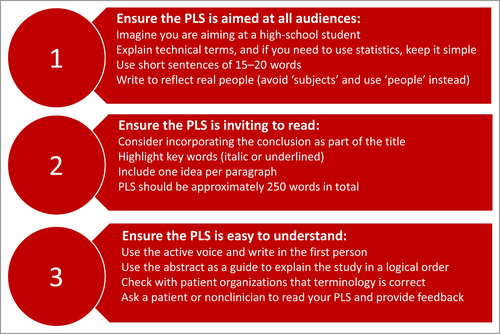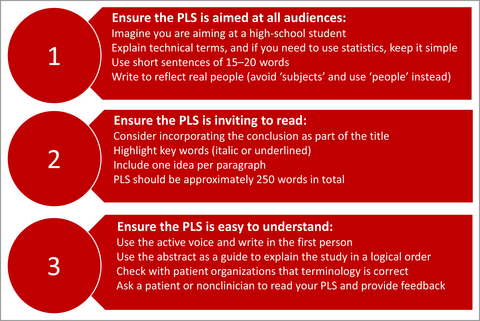Patient engagement with the BJD: encouraging the patient voice and readership
Conflicts of interest: O.H. and B.W.M.A. are the current patient associate editors of the BJD. L.P. is the journal development editor of the BJD.
Graphical Abstract
The British Journal of Dermatology (BJD) is currently ranked among the top three dermatology journals worldwide, with a recent increase in impact factor from 9·3 in 2021 to 11·1 in 2022. The BJD publishes leading scientific research from across the world, and the accessibility and real-world impact of this work can be increased with involvement from patients. Following on from previous editorials,1, 2 we have successfully maintained our partnership with patients to ensure that what we publish has a real-world impact.3 Our patient associate editors have first-hand experience of living with a skin condition, and were recruited in a collaborative approach to champion patient involvement in the journal.3 With the recent appointment of Olivia Hughes, the BJD is proud to have two patient associate editors with embedded links to skin-related patient societies and networks.
The patient associate editors play an integral role in the BJD’s editorial process and are responsible for the dissemination of research in an inclusive way for dermatology patients, through the production of a so-called plain language summary (PLS).4 To ensure we connect with dermatology patients, the BJD uses PLSs to share research studies in more straightforward language. Our patient associate editors check every PLS before publication, and edit them when necessary, so the results are understandable for all audiences; this is ultimately key for the dissemination and usability of empirical findings.
The BJD’s most recent PLS usage figures clearly show their impact, with an increase in downloads from 27 044 in 2020 to over 49 000 in 2021. A good PLS will be around 250 words in length and should explain scientific concepts in accessible language, so that anyone can easily interpret the results and clinical relevance of the work. For example, a PLS should summarize the primary study results in a relevant context to patients, with consideration of potential limitations of the research (see Figure 1 for three top tips for writing a good PLS).

To aid discoverability and understanding of their research, authors should explain the meanings of highly complex terms and give simple, concise definitions of the processes and methods involved in the research. This is particularly important when we consider today’s society, as these short summaries of bitesize information can be easily shared online and made available to everyone, irrespective of background, age or location. In doing this, we might successfully reach patients who may not find full research articles accessible. Although our PLSs currently do not have associated imagery, we plan to have graphical PLS abstracts in future, which we can post with the summaries.
Why is this so important? By publishing a PLS we are facilitating patients’ access to the most recent and trustworthy dermatological research, so they may make fully informed choices about their treatment options, and learn more about their condition. In doing this, we are helping patients to understand emerging findings on topics such as effective treatments, potential side-effects, lifestyle associations and health-related risk factors, which they can usefully apply in the real world to work towards living well with a skin condition.
Besides overseeing the BJD’s process of publishing PLSs, we are also encouraging direct input from patients and their societies. The BJD facilitates this by collaborating with patients through our Perspectives section. We are calling for submissions from people with skin conditions exploring thought-provoking subjects in dermatology.5 These articles are essential for reflecting patients’ real-world dermatological experiences and viewpoints. To ensure we are inclusive, promote choice and encourage participation, the journal has recently decided to accept (from patients only) submissions in creative formats, including videos, artwork, cartoons, essays, stories, infographics and poems, alongside traditional written articles, with a limit of 750 words, one figure or table, and up to five references. We encourage patients to contact us ([email protected]) if they need any help with their manuscript or have any other ideas not listed here. In a novel attempt to provide in-depth insights into dermatology practice, we are additionally encouraging co-produced articles from patients and their clinicians, to provide a viewpoint from both sides of dermatology consultations.
Including patients and their representatives in the research process is increasingly being used within scientific practice with the concept of incorporating target users with ‘patient and public involvement’ (PPI), for example via the National Institute for Health and Care Research ‘INVOLVE’ framework.3, 6 The BJD has highlighted the importance of PPI and its relevance to dermatology practice in our new podcast ‘BJD talks’,7 raising awareness of the work being carried out by the journal. Giving patients a role in contributing to the direction of future research might generate patient advocacy by providing patients with an opportunity to share their views on current dermatology practice, allowing them to articulate their opinions on novel topics, facilitating their calls for further research into potentially marginalized areas, and allowing scope to express any desires for future practice.8 In using the BJD’s Perspectives section as a platform for real-world content and encouraging people to contribute with personalized submissions in a format of their choice, we hope to work towards improving clinical outcomes and quality of life of people with skin conditions.
In terms of future directions of the BJD, we intend to keep expanding our reach towards improving the lives of people diagnosed and/or living with dermatological conditions, and their caregivers. We will do this by continuing to work in partnership with our patient associate editors, promote content from patients worldwide, and disseminate the highest-quality scientific research in accessible formats to have real-world impact.
We, at the BJD, are excited to be championing the importance of including patient perspectives in our work, and we hope our readers will be too.
Acknowledgments
The authors would like to thank the Editor-in-Chief of the BJD, John Ingram, for inviting us to write this editorial article. We would also like to thank John Caulfield, Eleni Linos and Shehnaz Ahmed for their guidance and valuable support.
Author contributions
Olivia Hughes: Conceptualization (equal); project administration (equal); writing – original draft (equal). Laura Prescott: Conceptualization (equal); project administration (equal); writing – review and editing (equal). Bernd WM Arents: Project administration (equal); supervision (equal); writing – review and editing (equal).





